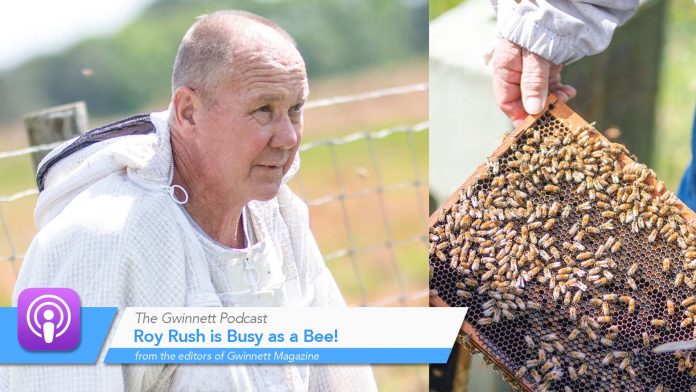Nothing says springtime in Georgia like azaleas and dogwoods. We’ll put up with a fine coating of pollen on our cars and patio furniture if it means we can enjoy a month-long feast for the eyes, itchy and watery though they may be. And when those blossoms open up, watch for the honey bees––and the people like Roy Rush who keep them––as they fly into action. There’s no lockdown for them. And the result of their seasonal work is as sweet as, well, honey.
Roy Rush climbs into his pickup before dawn this clear April day and turns onto U.S. 84, heading out of Cairo for Loganville, some four hours north. As the eastern darkness gives way to daybreak and the lights of south Georgia disappear in Roy’s rear view mirror, it won’t be long before he sees blooming redbud, black cherry, and dogwood trees.
Awaiting Roy on a small grassy plot of land on the outskirts of Loganville are eighteen wooden boxes––beehives––each occupied by thousands of bees. Each hive is meticulously nurtured by this 69-year-old Illinois-born Navy veteran, who’s made beekeeping his livelihood––and his passion. He spends hours each day working the hives to create the perfect environment to raise the most bees, then moves them to where they can make the most honey: Cairo with its tulip poplars and Tupelo trees early in the year, then Loganville in springtime. And when the blossoms fade, it’s on to the sourwood trees of Blairsville in the summer.
“I’ve got that Midwest work ethic. I’m not afraid of the work,” says Roy with dozens of honey jars on his truck bed still waiting to be delivered. That’s just part of his job this day along with checking on the wellbeing of his hives and driving back again to south Georgia.
“I like being busy.”
Good thing.
It all started as a birthday gift, a one-hive starter kit from his wife, Donna.
“She was trying to get me a hobby that would keep me home. Now she’s wondering if that’s good or not,” he says with a laugh, “because I spend a lot of time with the bees.”
It’s time well spent, because in Roy’s world, honey is money.
The bees in Roy’s keeping, busy though they may be, what with pollinating, keeping the hive clean for their queen, and making honey, pollen, propolis, and wax, are not as productive individually as you might think. In a bee’s lifetime, it’ll make about one-twelfth of a teaspoon of honey. By human standards, that doesn’t seem like much to show for six weeks of living, but there’s power in numbers; Each hive will yield 100 to 150 pounds of honey, and with a total of 150 beehives and honey going for some $20 a pound, you can do the math. Let’s just say it more than pays for the gas on the Cairo Beeline Express.
Tending to living creatures is nothing new to Roy or Donna. Back in the ’80s they had what amounted to a zoo on their twenty-acre piece of land in Loganville. Donna, after she became pregnant, realized that her horse riding days would be put on hold for a while, so she started a pony ride attraction for kids’ birthday parties. The menagerie grew to include pot-bellied pigs, ostriches, kangaroos, turkeys, wallabies, and hamsters, among other furry and feathered friends that naturally drew crowds from schools in the area.
9/11 put the brakes on the field trip business and eventually the animals either died, got sold, or ended up on Roy and Donna’s wall. All that’s left today are camels and ducks. Oh, and bees, of course.
Even before his 35-year career as a sales rep for a fastener company up north wound down, Roy began replacing his briefcase and samples with honey extractors, queen excluders, and brood chambers.
While probably 95 percent of beekeepers are hobbyists who do it for their own honey or to pollinate their gardens, commercial beekeepers like Roy are in it for the long haul, come what may: bad weather that can destroy a hive, pests that can be fatal to bees, and, of course, the bee stings. Lots and lots of bee stings.
“That’s why not everyone’s a beekeeper,” says Roy, who gets stung virtually every day, multiple times. But before you question his sanity for not doing his job in a suit of armor, consider this: Roy has had one knee replaced already and knows that his other leg is in need of a knee replacement as well. But, he says, “Bee stings kept me from getting it done five years earlier.” Apitherapy, says Roy, is a beautiful thing and a boon to arthritis sufferers.
“You pick up a bee, tap its butt wherever you want it to sting you, and she’ll sting you,” he says, as he demonstrates on the back of his hand. “Whenever you pull away, that stinger stays in you. And you wait a minute, then you take your fingernail and scrape the stinger away.” Then with a smile, he adds, “You’ve just had a dose of bee venom.”
And that, apparently, is a good thing.
So if you can stand the stings and the uncertainty that goes with relying on the weather and the temperament of your bees, you may have Apis mellifera in your future. If so, Roy suggests you do what he did: join a local bee club, take a course, and connect with a mentor. That’s one man’s formula for success.
“I have a business where I have little competition and I can make money at it. But there’s no doubt, there’s work.” That work’s satisfaction comes in a tangible way.
“Whenever you get a hundred pounds of honey and your back’s hurting, you’ve got something to show for it.”
Which makes the ride back to Cairo that much sweeter.





